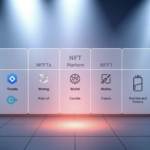Now Reading: AI Crypto Token Vesting Schedules and Cliff Periods Explained
- 01
AI Crypto Token Vesting Schedules and Cliff Periods Explained
AI Crypto Token Vesting Schedules and Cliff Periods Explained

This guide explains why well-designed release plans matter for projects that aim for long-term success. Smart, rules-based releases help align teams, early backers, and communities. They also reduce sudden supply shocks and calm price volatility.
Vesting is a planned release of tokens over a defined period, usually enforced by smart contracts on chains like Ethereum. Unlike a simple lockup, a release plan can be linear, cliff-based, milestone-triggered, or graded. It may be revocable or irrevocable.
We will walk through core terms, mechanics, governance, audits, and tooling. Expect practical advice on platforms such as TrustSwap and Team.Finance, custody options like Coinbase Custody and BitGo, and audit firms including Quantstamp and ChainSecurity.
What to expect: frameworks to choose the right schedule and cadence based on project maturity, investor needs, and market realities.
Key Takeaways
- Thoughtful vesting builds trust and reduces short-term selling pressure.
- Smart contracts automate releases and improve transparency.
- Different models (linear, cliff, milestone) suit different project goals.
- Use audited tools and custody partners for reliable execution.
- Align schedules with team incentives to support long-term success.
Why AI Crypto Projects Need Thoughtful Vesting Right Now
Today’s market cycles push projects into rapid hype and sudden liquidity, which makes disciplined release plans critical.
Present-day tokenomics pressures in AI-driven crypto
Fast hype and large inflows can spike circulating supply very quickly. That surge raises risk of sharp sell-offs that damage token value.
Well-designed vesting and clear distribution paths slow releases. Slower supply growth helps markets absorb selling without panic.
Investor confidence and community trust signals
Investors closely read published timelines to judge founder alignment and project goals. Transparent schedules signal long-term commitment and reduce uncertainty.
Teams that lock grants and use a visible dashboard gain trust. Early investors often accept paced unlocks when they see credible governance.
- Fewer sudden unlocks: reduces price pressure during key build phases.
- Paced distribution: aligns investors with multi-year roadmaps for sustained support.
- Team retention: structured releases retain scarce talent and tie pay to delivery.
| Challenge | Mitigation | Benefit |
|---|---|---|
| Rapid liquidity surges | Phased releases with short cliff | Steadier price discovery |
| Lack of transparency | Public dashboards and detailed timelines | Higher investor confidence |
| Team turnover | Time-based releases tied to goals | Better retention and delivery |
Bottom line: rigorous release design is a practical defense against pump-and-dump behavior and a foundation for long-term success.
AI crypto token vesting schedules and cliff periods
Careful timing of unlocks creates predictable liquidity and builds market trust.
Vesting is a phased release that aligns rewards with delivery. A lockup is different: it keeps holdings fixed until a single release date. This contrast helps teams and investors choose the right path.
Key terms and structures
Define a vesting period as the total span over which releases occur. Many plans start after issuance or employment begin dates in legal docs.
A cliff is an initial span with no unlocks, followed by a first release. Releases then continue on a set cadence.
Automation and types
- Smart contracts encode the release plan and emit tokens by block or interval, cutting manual steps.
- Linear releases spread equal amounts over time.
- Milestone-driven releases tie payouts to roadmap delivery.
- Graded releases vary sizes to match retention goals.
Best practice: publish clear docs and on-chain rules so distribution language, whitepapers, and code match. That prevents disputes and boosts accountability.
Mechanics: From Cliff to Linear and Milestone-Based Releases
Practical release mechanics let teams match unlocks to hiring, product milestones, and market cadence. Clear rules reduce surprises and make it easier for markets to price supply changes.

Cliff timelines and common lengths
Cliff vesting means no tokens released during an initial span, then a first unlock that reflects accumulated time. Typical cliff lengths are 6, 9, or 12 months. Longer cliffs boost retention but can make offers less attractive to hires.
Linear cadence: monthly, quarterly, annual
Linear releases spread portions evenly after any initial cliff. Monthly cadence smooths market absorption. Quarterly or annual unlocks cut transaction overhead but can create lumpier pressure.
Milestone-based releases tied to roadmap goals
Milestone-based vesting links partial releases to deliverables such as testnet, mainnet, or product launches. This ties tokens released directly to progress and reduces the risk of paying for inactivity.
Hybrid and graded schedules for nuanced incentives
Hybrid plans mix time triggers with milestone gates so funds move only when work is done. Graded schedules vary portion sizes over years and may be back-weighted to secure long-term commitment. Document exact percentages, intervals, and conditions and publish a public dashboard so stakeholders know the timeline ahead.
| Type | Typical span | Market effect |
|---|---|---|
| Cliff then linear | 6–12 months then 1–4 years | Smooth entry after initial lock |
| Milestone-based | Aligned to roadmap | Ties supply to delivery |
| Hybrid/graded | Multi-year | Retention-focused, lower short-term sell pressure |
Team, Advisors, and Early Investors: Aligning Long-Term Commitment
Aligning economic incentives with contribution timelines keeps founders and supporters focused on long-term goals.

Vesting that paces upside makes the team and advisors work for sustained delivery, not a quick exit.
When team members see staged rewards tied to milestones, they stay focused on product work that drives project success.
Careful token distribution discourages early dumping, lowers short-term risk, and supports healthier market liquidity.
- Advisors often receive shorter but meaningful plans to match periodic input while keeping alignment.
- Early investors should have release terms that reward long-term support rather than one-time gains.
- Diversify timelines by role seniority to avoid sudden large unlocks that can distort governance.
Publish schedules publicly so the community can monitor alignment and spot conflicts between private gains and public goals.
| Stakeholder | Typical structure | Purpose | Key benefit |
|---|---|---|---|
| Founders / leadership | Multi-year with back-weighted unlocks | Maintain focus on roadmap | Stronger long-term commitment |
| Team members | Time-based with milestone gates | Retain talent, link pay to delivery | Higher chance of project success |
| Advisors | Shorter staged grants | Reflect periodic contributions | Flexible alignment |
| Early investors | Phased releases over years | Reduce sell pressure | Steadier price formation |
RTUs and Crypto Compensation: Structuring Token Grants for AI Teams
Compensation plans that pay in tokens should mirror familiar equity tools while addressing unique payroll and tax mechanics. Start with a clear grant agreement that lists the total award, the vesting period, the cliff, and release cadence.

Restricted Token Units vs traditional equity analogs
RTUs resemble RSUs but settle in tokens. They align team outcomes to platform growth and upside while avoiding stock issuance complexity.
Key differences: token delivery timing, on-chain custody, and potential tax events at each release.
Time-based with one-year cliff
A common baseline is a one-year cliff followed by monthly releases over four years. This model balances retention with predictable pay for team members.
Back-weighted, milestone, and hybrid designs
Back-weighted plans pay larger shares later to secure long-term commitment from senior hires. Hybrid and milestone-based vesting tie portions to product launches or adoption goals.
Payroll, tax timing, and 83(b)-related considerations
Each release can trigger payroll actions and tax withholding. Escrow arrangements may affect eligibility for an 83(b) election and timing of income recognition.
Use automated payroll and a clean token table to reduce errors. Document the full release cadence in grant agreements and run audits through reputable platforms.
| Design | Typical span | Administrative notes | Best for |
|---|---|---|---|
| One-year cliff + monthly | 4 years | Standard payroll workflow; predictable tax events | Most team members |
| Back-weighted | Multi-year | Requires clear later-period documentation; retention-focused | Senior researchers, lead engineers |
| Milestone-based | Aligned to roadmap | Needs verification gates; can complicate payroll | Key hires tied to deliverables |
| Hybrid | Custom | Combines time and milestone triggers; audit recommended | Critical hires with mixed responsibilities |
Tokenomics Impact: Supply, Price Stability, and Market Liquidity
Well-timed release plans shape market supply and influence how holders perceive value. Vesting governs the tempo at which tokens enter circulation, shaping short-term scarcity and long-term token value.

Managing circulating supply to support token value
When distribution is paced, exchanges and pools can absorb inflows without sharp price moves. Predictable release cadence helps keep order books deep and orderly. Projects that match emissions to real usage tend to grow liquidity in step with demand.
Mitigating pump-and-dump and volatility
Crypto vesting discourages quick exits by large holders and reduces the temptation to dump at peaks. Public schedules let investors anticipate unlocks and adjust positions calmly.
- Align emissions with growth: release more as network activity rises.
- Review cadence: avoid oversupplying during low-activity periods.
- Communicate clearly: ahead of unlocks to lower perceived risk and foster constructive dialogue.
Remember: vesting is a structural tool within tokenomics that supports stability, but utility design and governance still drive long-term success.
Designing the Right Schedule: Frameworks, Trade-offs, and Timelines
The right cadence depends on whether you need quick adoption or steady, long-term commitment.
Short vs long periods: Short timelines attract hires and early contributors but raise the risk of turnover after the first release. Longer spans improve retention and align incentives with execution, though they can deter risk-averse candidates.
Choosing cliffs and cadence to match project goals
Use a one-year cliff as a baseline for hiring competitiveness. After that, pick monthly or quarterly releases to match delivery tempo.
Match the timeline to milestones: larger releases should coincide with product launches or liquidity improvements so tokens released support demand.
Back-weighted schedules to secure multi-year commitment
Back-weighted designs concentrate rewards later to lock in multi-year commitment from key roles. This reduces early selling while keeping initial compensation reasonable.
Customizing schedules by stakeholder type
Different roles need different plans. Core team members benefit from multi-year, back-weighted plans. Advisors may take shorter, staged grants. Early investors need phased releases that avoid outsized market impact.
| Stakeholder | Typical design | Purpose |
|---|---|---|
| Core team | Multi-year, back-weighted | Long-term commitment |
| Advisors | Shorter staged grants | Periodic contributions |
| Investors | Phased linear or milestone-linked | Steady market absorption |
Practical tips: set small portion tokens for early unlocks to reward effort without flooding markets. Document the full schedule and run scenario models across years to stress-test outcomes in both bear and bull markets.
Investors should look for balanced vesting schedule design that ties payouts to measurable delivery and preserves a clear project long-term alignment. For a deeper technical primer on structured release plans, see what is vesting in crypto.
Implementation Toolkit: Contracts, Platforms, Audits, and Governance
A practical implementation pairs secure contracts with custody partners and visible reporting to reduce operational risk.
Smart contract deployment: use audited contracts on EVM-compatible chains and other networks. Define clear parameters for cliffs, intervals, beneficiaries, contingencies, and upgrade paths before launch.
Platforms and custody: turnkey services like TrustSwap and Team.Finance simplify setup for projects and investors. For institutional-grade control, pair contracts with custodians such as Coinbase Custody or BitGo to secure tokens during the restricted period.
Security and audits: engage third-party reviewers like Quantstamp or ChainSecurity and enable continuous monitoring. Add pausable functions, timelocks, and incident-response steps so the team can act fast on discovered bugs.
- Formalize governance with tools such as Aragon or DAOstack to approve changes publicly.
- Publish dashboards showing upcoming unlocks, cumulative emission, and recipient categories to boost transparency.
- Document roles, multi-sig keys, and legal agreements to align on-chain code with written contracts.
| Component | Recommended Providers | Primary Benefit |
|---|---|---|
| Smart contracts | Team.Finance, TrustSwap | Automated, auditable releases |
| Custody | Coinbase Custody, BitGo | Secure storage, institutional controls |
| Audits & monitoring | Quantstamp, ChainSecurity | Risk reduction, ongoing alerts |
| Governance & reporting | Aragon, DAOstack | Transparent approval and dashboards |
ICO and DeFi Context: Investor Signals and Controlled Unlocks
A transparent release framework in sale materials reassures markets by tying supply to predictable timing. That clarity helps investors evaluate early offerings with confidence.
Vesting as a trust anchor in token sales
Clear vesting clauses in whitepapers and grant agreements signal long-term alignment for founders and backers. When a published vesting schedule lists timing, amounts, and any cliff, buyers see lower residual risk.
Liquidity management in DeFi and staking ecosystems
Phased distribution curbs immediate sell-offs after a TGE and helps stabilize price discovery. Measured emissions feed liquidity pools and staking rewards at a pace the market can absorb.
- Publish upcoming unlocks on dashboards so investors can plan around tokens released.
- Coordinate emissions with protocol incentives so new supply meets utility demand, not pure speculation.
- Post-ICO governance should allow transparent adjustments to incentives without breaking grant commitments.
| Issue | Mitigation | Benefit |
|---|---|---|
| Shallow liquidity | Staggered release | Healthier spreads |
| Exchange due diligence | Public schedule | Faster listings |
| Speculative dumps | Aligned incentives | Lower short-term risk |
Bottom line: thoughtful vesting is a structural trust anchor in token sales and a practical tool for DeFi liquidity management, helping projects pursue steady long-term success.
Bringing It All Together for Long-Term Success
A clear release plan ties reward timing to measurable progress and steady market depth.
Well-crafted vesting aligns the team, advisors, early investors, and community toward shared goals. It makes a committed project easier to judge and supports project long-term aims.
Use audited contracts, reputable platforms, and public dashboards to build credibility. These tools help a committed project show predictable supply and maintain investor confidence.
Choose a schedule that maps to execution realities and anticipated liquidity. Consider back-weighted or hybrid designs where multi-year retention matters most.
RTU-based compensation with clear payroll and tax planning keeps teams focused on delivery while meeting obligations. Open updates about unlocks and milestones keep investors engaged.
Disciplined vesting underpins long-term success by syncing value creation with fair, predictable access to tokens and by strengthening the governance and trust needed for project success.















